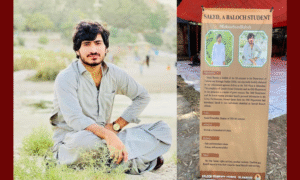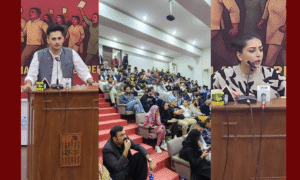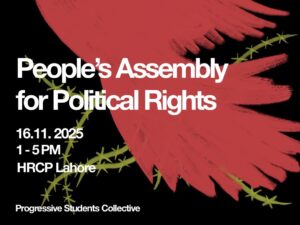Mudabbir Ali
The independence of India and Pakistan (from each other) was made possible through partition which later unfolded as one of the most violent mass-migrations in modern world history. At the end of the second world war it was clear that the colonial power was on its way back, meanwhile it had assumed the role of facilitating the ‘clash of interests’ between the rising political forces so that the power vacuum in absence of Britishers could be filled (of course in the greater interest of British Empire). The negotiations of power-sharing between Muslims and Hindus started as early as 1913 when Quaid-e-Azam left congress and became a member of Muslim League. Common place argument to explain the creation of Pakistan and India is presented purely on religious lines. Religion played an important role but it has very less to offer as an answer to the partition-led independence. The geopolitical aspect of Indian subcontinent gives a clearer picture to understand independence of Pakistan and the consequent freedom that has been attained.
Muslims in Pre-partitioned united India were majorly populated in north-western and eastern zones while the rest of the population was scattered all over India. Lahore resolution adopted in 1940 by Muslim League clearly stated that Muslim majority regions should be grouped together to form independent sovereign state(s) while its second part demanded adequate social, political and economic rights-meant to protect the rights of Muslims (as minority) who could not join the future Pakistan, for geographical reasons. This regional perspective is the hallmark of Lahore resolution which was later known as Pakistan resolution. As it tells about the deep insight of Jinnah’s political vision on maintaining the balance of regional power in a peaceful way and without breaking it up into pieces.
Looking at Pakistan’s independence movement from the viewpoint of majority-minority group dynamics, as well as considering the geopolitical reality of Indian-subcontinent helps in understanding the partition of 1947. It also attempts to answer the reasons for the fall of Dhaka in 1971. Historical evidence shows that in Indian sub-continent the idea of independence and partition coalesced with each other just as for Bengalis freedom and separation appeared to be. This illustrates that in our part of the world, the history of power-sharing and the negotiations around it involving different identities have always been a disaster. It does not surprise the world to know that modern nation-states are bound to construct an exclusive and selected form of history as the sole truth and in doing so every state underestimates those elements of history which do not favor its ‘truth’ and overestimates on those which amplify it. However, history cannot be discredited for the state’s nation building ideology.
One of the most pressing difficulties with Pakistan is still in finding its ideological anchorages; as over the course of history it has now become satisfactorily insufficient to stand merely on the basis of two nation theory. Also given the fact that today there are more Muslims living in India than in Pakistan and that Pakistan gave birth to another Muslim nation state in 1971- today’s Bangladesh.
Counterfactually, today it can be argued that the adjustment of power sharing on partition could have been avoided with some alternate means but as we analyze it today, at least one thing becomes pretty clear that nobody including Britishers, the political leadership on both sides and as well as general public thought of the horrendous outcome of partition. The communal violence that started with partition soon expanded to reach every nook and corner with mass-madness continued unabated for several months, killing as many as 2 million people. In the midst of bloodbath, the newly born states stood helpless and could only interven in the situation after thousands of rape cases were reported by families on both sides. As a result, a commission was made which rescued deserted girls from both sides in December 1947.
The case of the fall of Dhaka in 1971 further reinforces the geopolitical analysis to understand the partition and the contingent historical events that followed. Sheikh Mujeeb Ur Rehman, the leader of Awami league after winning the first general elections of Pakistan was dismayed by the response of West Pakistan. In fact, till the last moment Sheikh struggled to acquire its due power share. However, it was denied by the power corridors in west Pakistan. It was the inertia of partition that prolonged the process of power sharing between Eastern and Western wing of Pakistan just as the second world war pointed to the delay for the partition. The moment reached in the year 1971 where longstanding sufferings of Bengalis provided the foundational ground to go into war against Pakistan and to accept military aid from India to finally declare itself as an independent nation-state.
Today, reconciliation with the history of partition(s) is one of the persistent challenges Pakistan inherited amongst others. Like sharing an extensive border with Afghanistan on an unsettled Durand line, keeping one third of the total British Army, having just 17% of the total economic base and above all the ideological claim over Kashmir. Together, these geopolitical and economic realities put Pakistan in a real difficult situation to match its imminent enemy (India) which adopted its first democratic and secular constitution as soon as 1950. Contrarily, in Pakistan the civil and democratic institutions could not find space to grow as the issue of ‘security’ always occupied the driving seat of regional history. More than seven decades have passed, and the question of security of Pakistan supplemented with the Pan-Islamic religious impulse, has been the decisive factor of policy making both on internal and external levels. And it has been experienced in its different shades and colors; precisely in accordance to the prevailing global trends in the cold-war and post-cold war period.
The political bargains on security and the geopolitical positioning of Pakistan have chiefly benefitted a handful of dictators and their extended patronage systems at home, while abroad it protected the global interests of America and Saudi Arabia. In the aftermath of the 9/11 incident the security narrative in Pakistan once again touched its rise and is still on the surface for which the people of Pakistan have paid a heavy price in the form of loss of lives, homes, businesses and livelihoods. Whatever the reasons may be, but the excuse of becoming a ‘security state’ should not be compensated with the idea of peoples’ liberation and freedom.
The true meaning of independence and freedom would be to see people not as objects which can be transferred from one place to another as happened in partition, nor should be defined as producing complicit and docile bodies to render unquestionable sacrifices in order to protect the sanctity of state as was expected from Bengalis during 1971 debacle. Rather true freedom and independence would come with the acknowledgement that political movements, and political systems eventually created in the end are essentially premised upon the principle that it will serve the interests of people associated with it, and not the other way round.
The Students’ Herald News Desk focuses on reporting the latest news regarding student politics and campus updates to you.
The News Desk can be reached at admin@thestudentsherald.com




